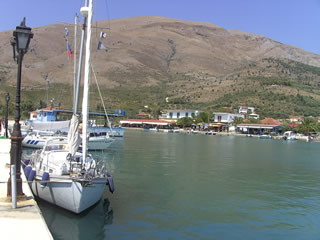
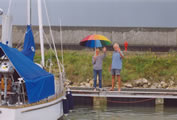
Back to the general overview, click here
Our English Pages (5.1)
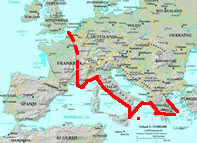 |
4. Greece 1.1. the Ionian,from Corfu to Lefkas and Fiskárdho,back to Belgium, Menton and Venice(2008) |
Overview and harbours, click here.
Greece, facts and dates, see at the end of this page.
Corfu
 |
14.07.08 Kerkyra (Corfu) Gouvia Marina. Yesterday evening we arrived in Greece, after a passage of 80 NM from Santa Maria di Leuca (I) - we start at 05.30 a.m. - to Corfu - we arrived at 08.15 p.m. (boat time), 09.15 (Greek) local time. We want to stay some days at Gouvia Marina, to clean the boat and prepare the Greek part of our project, but also to get the gluten-free products we ordered - not easy in Greece and with a delivery period here at Corfu of at least 6 days! To get a good working internet connection on board we will do three coming and goings with crowded busses and taxis: also this was much more complicated than in Italy ( see Kortom 10 )! But although in our mind Corfu is quite not the good example of the "Greek style and atmosphere", it's nice to find again from now the way of doing we left 15 years ago! Despite the hypertouristic (and mostly low budget styled) features of Kontokali, Gouvia, Dasia and Corfu-town - our present environment - we appreciate already what we always have found in our Greek voyages and stays: the difficult to translate feeling, of being "home". |
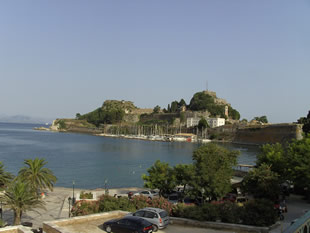 |
||
1. Nehalinnia in Gouvia Marina 2. Corfu city, the Venetian castle |
Sayiadha, Sivota-Moúrtos and Parga
31.07.08 Sivota-Moúrtos. Already a few days Nehalinnia is moored in the new harbour - paid for 75% by the European Union but still in construction! - of Sivota-Moúrtos.
After a little longer stay at Gouvia Marina, Corfu - little heath problems or little injuries are never far away, although you are very attentive and taking all precautions - we crossed to the mainland.
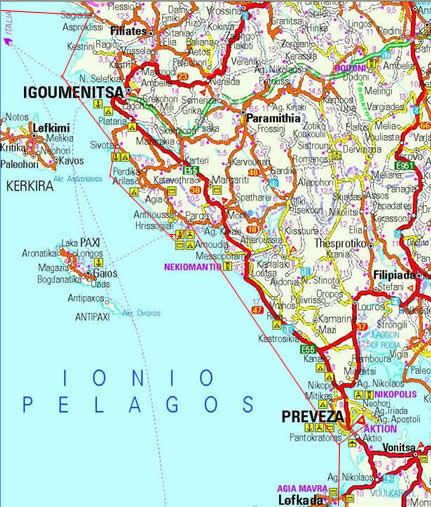 |
The little, shallow harbour -at max. 2m depth , mostly less - is not so visited, so Isaiah is rather authentic. Although: we hear from Corfiots, who keep here many times their sailing boat and are mooring it now for their holidays that flotillas steadily - weekly? - come into the little harbour: then it isn't really nice and you shouldn't be there - " once there were 28 charter-boats, a hell ", so they told! So our second stop is Sivota-Moúrtos: a "postcard-nice" touristic resort: a little village - is it really authentic? - a quay, very animated in the evening many tavernas and restaurants, shops for tourists - mostly Italians! - two little supermarkets, some little fishing boats - authentic these! - many sailing boats - and the unavoidable charters! - nice bays between the little islands, pleasant beaches and on the background the mountains of Epiros; then, in front of the village and the old quay, the "new" harbour .... |
[map: GNTO]
In Kaat's journal (transl., original in Dutch)
Sailing from Gouvia to Sayiadha is only crossing to the mainland, 14NM to the E avoiding a little corner Albanian territorial waters. No wind ... or less, "in the nose ", while the "prevailing" wind is N to NW ...
Thursday 31 of July 3.30 p.m., when I am writing this, a big wave - about 2 m high - breaks on the beach: everybody is wet, everything is gone, and a small kaïk, normally upright standing on the beach on a sledge, is now overturned. This was is not a normal wave! Fortunately we are the garden of the "beach club" and immediately we run to the harbour to look if everything is ok. Apart from a some swell there, nobody has felt nothing. Pfew!
Back to the story now ... quietness is back on the beach, the wet, dumbfounded sun bathers are coming back shyly, everything seems to be normal again ...
Saghiada is a very small, shallow harbour with a long quay and a very narrow, about 5 m, entrance. When we arrive there was nobody else, so we went alongside, almost in the SE corner and we asked the "harbour authority" if that was OK. "No problem" was the answer, "but if you stay tomorrow, it's better to use your anchor because, perhaps, big boats could come. And indeed ... a Bavaria 40 entered, trying to more alongside but grounded at 3m from the quay: so, time for using anchor and gangway plank. Two other boats arrived and nothing more. But then the NW wind came up: 18 to 20 knots and we understood that here it shouldn't blow more, the water was already splashing over the low and narrow wall. So we stayed here one night. A pity because here it's really "Greek", after Gouvia a quite relief. In the evening we had a marvelous sunset, we ate fish at a nice taverna and ... slept badly because the Greek were making much noise on this Sunday night.
 |
The next day we left at 8.30 a.m. to Moúrtos-Sivota. Michel and Mady, our friends from Menton, advised us to visit this little harbour. And indeed, it's very nice here and when we arrived at midday in the "new" harbour there was a lot of place - on the way, we could stop the engine and sail during about 10 minutes! Berthing on the old quay seemed us not a good idea: there are many tavernas and bars, and in the night it can be very noisy and very "moving " - and so it is!. Our boat is now "parked" alongside a little section of oblique quay, just long enough for us. In front of our boat everybody goes anchoring, stern or bow to the quay, behind us there is still just a little place for a other boat going alongside on the non-oblique quay at the entrance. Although there is no water, no electricity, we decide to stay here a little longer: there is a nice beach with a "beach club" where we can take a shower, we get water at the supermarket nearby and at night in the taverna where we have dinner. The two solar panels give us a part of the current we need, and we put the engine on when we use the laptop (this is the only problem: our pc devours current!). We want to let pass the bustle of the many charter boats and the agitated Italians: so we will try to "over-summer" a little bit ... |
16.08.08 Sivota-Moúrtos. Saturday evening and ... weekend of the August the 15th! The harbour is crowded, many Italian offshore-ribs - smaller Greek - taking much space, a Neilson-flotilla - 13 sailing boats - for a two-days-crew-change. Crowded too the old quay. The night is falling. A Greek sailing boat is entering the harbour; the skipper and his wife want to moore between our neighbour and us, he refuses also that we take alongside the rib of the Florentine family we met - as we do every evening; he's also blaming us for staying alongside the quay although it's the unique possibility: at this diagonal part of the quay it should be impossible to use our anchor without crossing several anchors of other boats. But the Greek Tasmanian Devil refuses to listen to these reasonable arguments: so, in confrontation with such intelligence and this common sense and being fed up with the crowd we decide to go anchoring outside the harbour and to abandon Sivota to her mad touristic fever. Tomorrow we will go to Preveza!
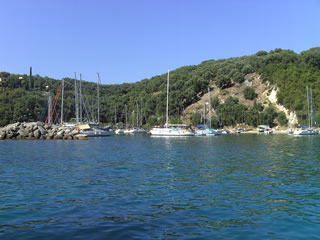 |
17.08.08 Parga, Ormos Valtou. At 10.30 a.m.and 12 NM further our anchor falls in the little fishing harbour, 0,5 NM of Parga, W of the Venetian fortress. We are lucky: a few Italian sailing boats are leaving (late, not?) and also the ten boats of the Sailing Holidays flotilla, one after another, after untangling their anchors ... For tomorrow strong winds are announced: so we prefer to be moored on the concrete mole rather than being anchored! And, we plan to stay here some days: there is a water tap on the mole and with our Italian neighbour we improvise a 150 m long cable to the poor electric case so that five boats can connect for battery charging. The spot is nice and gives a good compensation for the poor harbour where some wrecks - a few sunken - are the perfect illustration of the level of ecologic conscious in Greece ... if such was still needed! |
Preveza
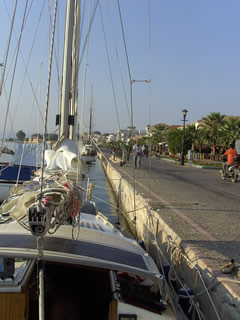 |
20.08.08 Preveza, town quay. After three days we leave Parga. From our Greek neighbours we got a delicious pot of apricots - filled with nuts - in honey syrup, a present to have kept a eye on their boat during the windy day - and night - when they had to leave. We arrive in the early afternoon after 28 NM of motor sailing navigation at Preveza. The wind is freshening when we are entering the narrow buoyed channel and we have to give way to a sand coaster. The new marina of Preveza - hardly subsidized by the European Union - is situated at the end of the town quay is still not completed although damaging is already started; occupied by small local boats, some charter companies and a community of north European long-stayers (our Danish friends mailed us that they were moored some days at the ... 'Swedish" pontoon!). No management ... no place! So we go to the rather empty town quay, what should allows us to get some provisions. Bad luck: on Wednesday afternoon most shops are closed! Preveza seems us a bit asleep on this very hot afternoon... |
Metamorphosis. At 9 p.m. the quay and the streets of the environment rustle of the animation: Greeks on holiday, Italians on the way back. The quay is fully occupied. The port police of Preveza is hard working: making rounds she is inviting with a nice, surely expensive, bilingual card - to come to the office for the port formalities. Because we want to leave early tomorrow for Lefkas we hurry to the port authority with our ship papers. We witness to an impressive demonstration of bureaucratic procedures: forms to fill out, control of the crew list, photocopies of the ship certificate and of the special insurance certificate for Greece. The result of this imposing scenery is the taxation of the port fees to an amount of 6,61 euro (VAT included!). In one of the well animated alleys we find a last table, where we can recover of this demonstration of administrative efficiency thanks to an ouzo and some Greek - gluten-free - specials.
At 4.30 in the night the music stops in the bars on the quay, but still our night at Preveza will not be quiet: noisy holiday makers and our rolling berth are keeping us in a half sleep. A not to be advised stop!
Lefkas Marina
21.08.08 Lefkas Marina.
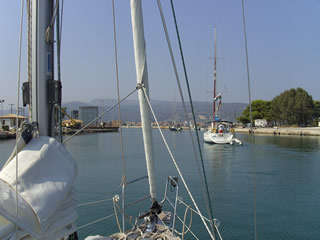 |
When we leave Preveza a strong current limits our progress in the channel: our GPS marks 3,5 kts on the ground; so we'll be to late for the 10 a.m. bridge at the entrance of Lefkada canal, 6 NM further. We'll anchor although it's possible to wait just before the bridge when it's not to busy, but now, outside, a little wind brings some coolness in this hot and humid atmosphere. Lefkas ... 19 years since we were here for the last time: from here we see new constructions, colours, the since 2002 operating marina ... The town was hardly hit by the serious earthquake of 2003 ( 6.2 -t 7.2 ). At 11 a.m. on the dot, the floating bridge opens the passage for four boats in N-S direction but the queue of N back to their country-going Italian sailing boats is very long; so, the queue of waiting cars also becomes longer and the impatience is growing ... |
We have some practical things to do here; the wintering in the marina has to be stated, gluten free products have to be ordered in Athens, our site has to be updated, and we have to resolve some minor technical problems; there is no self-service laundry in the marina but a quick laundry service will do the job. Lefkas Marina, one of the most important base of chartering boats, is well equipped and offering all services and facilities. In town too there is no lack of shops and services. After almost twenty years what's striking us at first sight is not a dreaded standardization to " international tourism ", but the increasing of the offer on quantity and quality: Lefkas town seems us still very "Greek" - except the close neighbourhood of the marina - and to have kept more authenticity than Corfu and - at a very lower scale - Sivota, where tourism centred to international customers, in summer with an important Italian component - almost exclusively, at Sivota - has brought very much changes. Prices too seem to be lower here (23.08.08).) Although Greece is on economic matters one of the "worries" in the European Union, a bigger part of the middle class is now able to take more expensive holidays. So it's an evidence that "the offer" is less and less first and foremost and exclusively aimed to foreign tourists. Far is the time of " Greek protectionism " like we have felt in 1976, checking every import; and if many Greeks - but they are not the only one! - are considering that " Europe " is responsible for their (real) difficulties - what we frequently hear - it cannot be denied that this country has very well benefited from the very generous manna of the Union.
So we want to stay here some days before continuing our trip along the coast of this island, in the Inland Sea, and later on, in the direction of Ithaka, Kefalonia and Zakinthos.
01.09.08 Lefkas Marina. While I was translating this you are reading, on monday the 25th, suddenly the display of our laptop become heavy full-white ... Two hours later the verdict of the technician was given; impossible to repair.
One week and many worries and problems later, our new laptop is operating and we can progressively start to update our story ... But we have still an other (little) problem: our order of gluten-free products was not well understood in Athens ( for this matter Greece has to learn from Italy! ), so what they send to our pharmacist in Lefkas has to be completed. It seems that hitches are making coalitions!
Sivota and Fiskardho
07.09.08 Sivota N. Levkas. Since yesterday we are at Sivota after following the E-coast of Lefkas southwards. We followed the Lefkas Canal to Ligia - a little fishing harbour where we had a look. Then we sailed in the direction of Nidri. First the wind was NE - about 15 kts - then suddenly half way in the Meganissi Street, by N.Thilia island , the wind became SW: so we saw a N-going sailing boat under spinnaker when S-going boats are on quartering wind.
.jpg) |
Sivota: on an evening, twenty years ago, from Amousso, where we went camping, we came with our friends Zodiac rubber boat, eating here. It was in the full high season and we found that it was very crowded. Now we are moored on the south quay; when we arrived at midday many places were unoccupied. At seven p.m. all berths were taken and some yachts were anchoring in the bay. Many Greeks came for the weekend with small motorboats to Sivota so now a certain animation is reigning on the quay, but during the evening every body is scattering in the numerous restaurants and tavernas. We can, although, easily imagine that during the season it's really to crowded and that this nice place changes in a hell! Some charter boats seem to be already crewless, or is it an illusion? In the restaurant where we have a nice meal - stuffed wine leaves, pan-fried aubergines, grilled lamb chops and tomato salad - only a quarter of the tables are occupied. For choosing a restaurant we look always to the presence of Greeks,to the absence of pictures of the plates drawing tourists, and to the absence of waiters trying to take clients attention by a horrible "Hello"! |
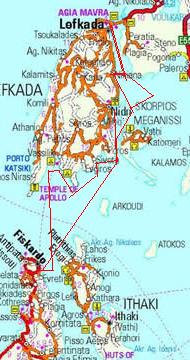 |
At a terrace with little platform, rather improvised, a little band plays - too loudly - what has to be popular music, but the musicians are forgetting some notes and the voice of the little to pulpous singer is not always so correct. Although, on this saturday evening peoples interest in the concert, announced by garish posters ... and till deep in the night our attempts to find some sleep are vain due sudden musical slips ... We decide to stay some days at Sivota to explore a little the place and to enjoy swimming; it's still hot from midday to sunset, so we prefer our large sun tent to the bimini, and we hoist the wind scoop. Because there is no electric supply here, we have to make maximum profit of our solar panels; the new laptop less greedy than the previous is still counts heavily in our electrical consumption. 09.09.08 Sivota N. Levkas. Tomorrow we will go to Fiskárdho. From Sivota we'll keep the souvenir of a nice encounter: by Christos and Ioana, traveling on their recently acquired sailing boat, we understand that our rising fears perhaps could be unnecessary - the Greeks seemed to have changed, their hospitality shouldn't be still like it was, their kindness to foreigners and travelers would have disappeared .. For Eric's birthday, the music of Christ os' accordion will lull us: after some very ... Parisian melodies, his nice and deep voice will let us dream of the eternal Greek thalassa ... 10.09.08 Fiskárdho, N Kefallínia. Before we cross to Kefallínia, we go to explore the bay of Amousso; nice well lined beach chairs, same coloured parasols, then, the road, asphalted until the beach, a nice low masonry wall - through our binoculars we observe how the wild camping has been turned into a (to) nice beach for tourists; around the restaurant - unsophisticated, in that time - we note the car parking with sun protection, the lodges with straw roof, little enclosures, and we imagine the to green lawns ... the ancient colony of nice various people, well living in the summer dust of the place, with tents and motor homes - and, already then, fast ribs - seems to have given up the place to more civilised and hardly sun needing tourists... but so sadly stereotyped! |
[map: GNTO]
The cross of the Stenó Kefallínias: nine nautical miles from Amousso to Fiskárdho. We are not alone at sea but the quietness is coming back, most of the sailing boats are charters, mostly parts of the traditional and unavoidable flotillas. Approaching the passage between Itháka and Keffalínia we come constantly nearer by the wind and the sea is slowly building up. Still two nautical miles to our waypoint for Fiskárdho; we are now navigating against the wind, which is blowing by gusts, but with the waves, and a rather heavy and short swell steadily hides us the lighthouse. Due to our mainsail we can keep a good course but those sailing for the easiness without main appear to us under the most different angles, on the top of the wave, before disappearing in the wave bottom and reappearing on the next top, rolling and dancing ...
We find a place at the floating pontoon; our anchor falls in 9m water... and then Kaat succeeds in realising a perfect approach with our long keel sailing boat ... but when we want to give our ropes to the on the pontoon standing nice Indonesian crew of a big yacht, we see that in our wondering we have forgotten to fasten the ropes; this causes a friendly hilarity by our temporary berthing helpers. The omission is quickly repaired, so that we are moored at ... Fiskárdho, the place that should be - following the touristic and people magazines the ... new St-Tropez! ....
.jpg) |
The small harbour is still very busy, sailing boats are looking for a berth, little ferries are coming - unloading their human touristic freight - and going, creating a wash... Our first impression is that all this, despite the nice coloured and well restored houses, has only a poor resemblance with the charming place we visited twenty one years ago ... but we try not to make our opinion to early ... Our attention is rapidly taken by the approach of a sailing boat from which the crew is still not expert in the manoeuvre: dragging their anchor they finish by stopping their boat square to our left neighbour, a motor yacht, and getting back anchor up they take also an other chain with. From the pontoon contradictory advices are bursting forth, on the boat hands are trying to keep the two boats in distance, silences, questions, indecisions, irritation by the flotilla leader, worrying witnesses, confusion, and then ... finally, the indispensable intervention and assistance of the Expert, with his dinghy, new approach, new manoeuvre, dictated with precision from the pontoon ... twenty minutes later, they are moored, relieved, apologizing for the trouble |
Thunderstorm
15.09.08 Fiskárdho, N Kefallínia. A violent thunderstorm spreads anxiety and destruction... Without willing to lapse into sensation, we try to reconstruct what happened, while some pictures in our photo album will perpetuate our souvenirs (see Fotoalbum). But, first, we have to go back to yesterday, Sunday. The weather is very nice, warm, the little harbour is crowded, and in the N of the bay, about ten boats are at anchor, with long lines to the rocks or to some rings ashore. When my wife and I are going back after a nice and refreshing swim under the Venetian tower, we see how, in the cockpits, the crews are enjoying the charms and pleasures of anchoring - here, people felt into the seduction of reading, there, others are joking and having a good drink, on another sailing boat the skipper and his wife seem to enjoy the quietness in the last heat of the late sun ... But, unfortunately, we know that bad weather is coming: our gribfiles www.grib.us give us the certainty that tomorrow heavy rainfall will come down on the region but Kaat and I fear a violent thunderstorm; we have doubled our mooring lines to the pontoon and checked the good holding of our anchor; anyway, most people think that it will not be so bad ... "Not here, now ..."!
Monday 02.30 a.m.(LT). A (first) thunderstorm breaks out: a first gust, very hot air, some big drops, dry again, a second gust - other air, clearly more cold, now -, thunder far away, a lightning. From one of the bars, where things still are going musically load, some clients come outside to marvel at the rain - since longtime forgotten - and the lightning. Jokes ...
I wake up Kaat, a feeling of deep mistrust isn't leaving me, we put away and fasten everything; our new - Swedish - neighbours, also waked up; she, she is meteorologist and doesn't like thunderstorms; "So, anyway, we'll get some thunderstorm ..." Kaat goes back to bed, I'll stay awake; we want to avoid that we should be both to tired in case we have to leave the harbour ... A serious swell of the south is now entering into the bay, yet mentioned as an all round shelter! At 03.30 a.m. (LT), the very large yacht anchored more forward, leaves the bay ... I'm following his departure and feel some anxiety ... At 5'clock the thunderstorm is over; finally, we had not much rain but many lightings and violent thunder. The swell is now uncomfortable but seems to be easing... I'll try to sleep for a time. Not easy ...
At 7'clock Kaat wakes me up: " Quick, get up, things are going wrong! "
In the cockpit I realise like in one flash - incredulous - the chaos around us: about ten sailing boats are trying to turn around in the little bay while three other boats are leaving, entering the Ithaka Street, in the direction of the sea or the island Ithaka ...
A second thunderstorm is breaking out: lightning everywhere, the thunders seem to never end, a down-pour is coming over the harbour, the rain is whipping the hard working crews; I see how here one is trying to fasten better the boats onto the pontoon, how others are trying to make better holding for their anchor; there small boats are moored on the inside of the pontoon by two drenched Greek women of the renting agency; on the other side of the harbour masts are dancing a uncoordinated ballet; at the terrace of a fashioned restaurant large parasols are torn, scraps swinging into the gusty winds ...
Suddenly a very heavy swell, to high, is rolling in ... Kaat says: " I am afraid that we'll have to leave ..., no, ... let's wait ...". We start the engine, while our small sailing boat is pulling at his mooring lines ...
.jpg) |
When we look up, we see, through the around turning boats, three sailing boats on the rocks, one of them has already partly capsized ... Three quarters of an hour later, the thunderstorm leaves the tortured bay ..., the rain is disappearing, the wind continues blowing around 15 knots, but the swell remains ... In the early afternoon, a new reason for anxiety: the wind and the swell are increasing. Again mooring lines are reinforced. the anchor of a beautiful steel ketch, under Spanish flag - the owners had to leave for a while - is jamming his neighbour, a Swedish 36 feet: the very active skippers wife doesn't trust it and convinces her husband. A long mooring line will be fasten to the ferry pontoon passing in front of all moored boats. At 03.45 p.m. (LT) at last the wind is veering W, and some minutes later the swell in the harbour has to give up; when then the sun is breaking through the clouds, bringing some colours, the calm comes back ... |
Sad toll: two sailing boats could be liberated from the rocks at the end of the morning by the little rescue boat, one of them - with severe damage - was tugged to the quay, but for the third one - a beautiful 40 feet under UK red ensign - the consequences are more dramatic: the hull ripped open for a large half square metre made vain every attempt despite pumps and other deployed means ... till, at the end of the day, a huge crane could lift the boat out of the rocks and the water ...
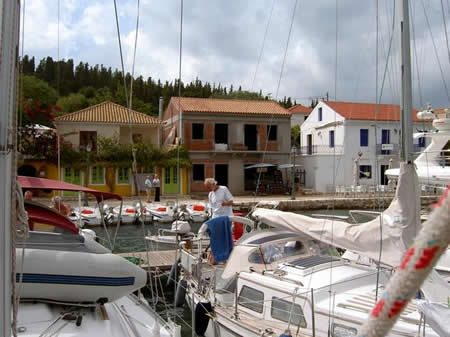 |
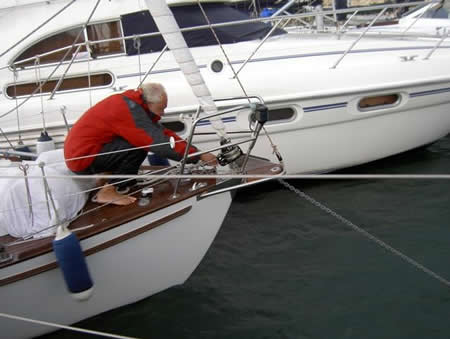 |
Fiskárdho: if we can believe the people magazines and numerous touristic publications, the new St-Tropez ... in Rod Heikell's pilot - an authority - ( Greek waters pilot , Imray ) we read: "excellent shelter from all directions, although strong prolonged southerlies cause a surge, troublesome rather than dangerous ..." (2004, updated till 2007, p. 92) ; in the Greek pilot of Nicolas D. Elias ( updated till 2008 ) it's said "shelter from all but SE winds, this wind blows mostly in the winter ... " ; following our experience and the local knowledge, Fiskárdho isn't a real save shelter by bad weather, this holds particularly for the N-side of the bay, where the anchorage is located; this was a short thunderstorm with a sudden strong S-ly wind and a important swell; but also a strong NW wind creates a heavy swell, if we believe the locals, so that even the floating pontoon, W in the harbour isn't save.
Back to Lefkas Marina
16.09.08 From Fiskárdo (N.Kefallinía) to Nydrí, Vlychó and Lefkas Marina. The wind is - again - south when we leave the bay of Fiskárdho; over Lefkas, the sky is very dark and we see a rain curtain over Vasiliki. According to the weather forecast the wind will remain south until he will reinforce, veering NW in the afternoon;and again the threat of a thunderstorm is real; for tomorrow too the NW wind will be strong and for saturday bad weather is announced. Rather than continue our trip along the not so save harbours and anchorages of Kefallínia and Ithaka, we decide to go back (for some days ?) to Lefkas Marina. Despite we realise being thrown from a high summer to an early autumn, we hope, when we see the sun breaking through the clouds, that the day will be a little nice. The sky is wonderful and the sea is sparkling of extraordinary luminous glints. Keeping our course we have have a backstay wind, so with two reefs in the main, we try to keep our genoa 1 free and full. When, for a time, the wind is easing under seven knots, we start the engine. Approaching Lefkas I am thinking of what I read in the Greek pilot by N.D. Elias. Between the SE of Lefkas, the N of Arkoúdi and the SW of Meganíssi - and further on to Kalamos, Kastos and Atokos - at the end of the summer ( second part of August - first part of September ), in the afternoon of very hot days, the very dangerous Liovóri is blowing. Today conditions are quite different - it's not very hot and it's to early in the day - but it seems imperative to me to keep this local hazard in mind.
.jpg) |
When we are approaching Nydrí the number of sailing boats is heavily increasing: the bay is large and is a base for many charter companies. But we read that the bay is very polluted: on the W bank there are numerous shipyards and, mainly, Vlychó is not only a well-known anchorage for numerous longstayers, but also an important wintering place. At some yards or parts of quays we see wrecks, some are sunken or half under water. Because we know that this is not an isolated fact, but that let die boats that way is a widespread method in Greece, we feel increasing irritation and anger confronted to such a lack of environmental conscience, to the absence of intervention from the authorities,to the hypocrisy of a government of a country so widely financial sustained! |
A few nautical miles before the S-entrance of the Lefkas canal - very careless buoyed - the wind is NW, like we expect, and the cloudiness is increasing rapidly. When an hour later we are mooring on the berth where we were directed, the thunderstorm is breaking out: Kaat is putting the genoa in the locker when the first drops are falling. When we have dinner in our nice little restaurant, already usual, close to the " devastated " museum, and later on, during a large part of the night, the moon and the lightning are squabbling for lighting the night... When, on our way back to the marina, we meet the Norwegian couple who left, on their 43 footer, the harbour of Fiskárdho when the thunderstorm was breaking out, and we are comparing our souvenirs of this blasted thunderstorm, a treacherous shower makes roughly an end at our conversation ...
19.09.08 Lefkas Marina. Wednesday. The weather forecast is correct: a windy day but the sun brings nice moments, despite all ... until in the middle of the afternoon, again, the clouds are coming ... In the early evening, we have a walk along the road to Castro, at the end of the small isthmus; this straight road links the island to the mainland, the ferry is acting as floating bridge. the declining sun is illuminating the sky and the waters of the lagoon by red and pink glints. From here the view carries to the bay and Preveza, far off. When we look to the NW and the W, it's the Ionian Sea we see, and whipped by the strong wind, her waves are breaking on the island coast. Before we go back we overlook the surroundings and the small Lefkada town: the fort Santa Maura of the XIII th century, just on the N entrance of the Lefkas canal, behind the sandbank, the ferrybridge, the canal, the marina, the town where the lanterns just go on, the road; on the other side, the salt lagoon, and behind all that, the mountains of the inland, with the highest top, the Eláti, 1158 m. For the first time, this evening in our nice restaurant we eat inside, for the first time ...since the thunderstorms in Rome. Thursday. Our evening walk brings us an other time to Castro. And, again, we'll have our dinner inside. Today, Friday. Under a light cloudy sky, but by cold and windy weather, mainly in the afternoon, I work to update our website. Is the rigorous coldness of the after -summer already arrived?
25.09.08 Lefkas Marina. It's 10.30 p.m. and, along the quay we are going back to the marina. When our mobile is ringing, we know that we will hear very bad news. On Monday Kaat's mother got a serious cerebral haemorrhage and a fatal issue is probable. ...
Brugge, two days before our departure on March 7th 2007. Mother accompanied us on the terrace and, enthusiastic as always when something particular was happening, she had waved goodbye. One moment she has been serious - I know that we shall never see us again, but you have to do what you have decided, so she has spoken to Kaat. A large map was lying on the table. She could follow us.
From every stop, Kaat sent her a postcard, when it was possible she indicated the exact place where we were mooring.
This night the nice images of the separation in the garden are remaining on our retina and we want to cherish them tender.
Back to Belgium
29.09.08 Nieuwpoort. At 10'clock the taxi has taken us in the marina. Europ-Assistance, our travel insurance, has organised our return with great precision: the fly from Preveza to Athens, the seats for the OlympicAirways fly to Brussels, and the taxi to bring us to Nieuwpoort.
01.10.08 Brugge. 11 a.m. A watery sun. Family, friends, acquaintances - of the school, where she was teaching, as an early widow,till she was sixty-five, of the choir, from the folk-dance group, from the local corporate live, numerous they are here. Autumn. The afternoon will be windy and showery. The cemetery De Blauwe Toren is colouring in variations of dark en light tints, green, yellow and brown. In a quiet but emotional silence, they are here for the last farewell to their mother, her sons and daughters, her grandchildren. Then, suddenly, a increasing wind takes her to the big and stately trees, to the dense brushwood. Ecce homo ... only remains the nice, heart warming souvenir... (updated 16th of October 2008)
Menton
20.10.08 Menton (F). 9.15 p.m. We are landing at the airport of Nice-Côte d'Azur. A quarter of an hour earlier the Easyjet has started his landing manoeuvre, leaving Turin to port and making a big half-circle above the sea; in front of us, Monaco is lying in a bay of light. A little later Michel and Mady are welcoming us; they bring us to the harbour of Menton-Garavan; very friendly, they give us their sailing boat for our stay.
24.10.08 Menton (F). We plan to return to Lefkas in the beginning of November, going first to Venice where we'll take the ferry to Igoumenitsa. But first on we want to enjoy the reunion with our friends. Rinaldo and Marise, back from Kos since a few days, tell the story of their long cruising to the north of the Aegean Sea: from Kos to Chios, Lesbos, Limnos and Samothraki they sail to Thassos; going WSW they sail along the "fingers" of Chalkidiki to reach more southwards Skopelos and Alonissos; they didn't continue to Skiathos and the Pagassitikos gulf because of the increasing crowd, preferring a pleasant stay at the little and quiet island of Psara. Their very useful information didn't reassure us for the rest of our trip. Compared with their experiences of the last years, the number of people and boats has increased strongly also in this part of Greece - due to the increasing number of hire boats and flotillas and due to the rising prices in Croatia.
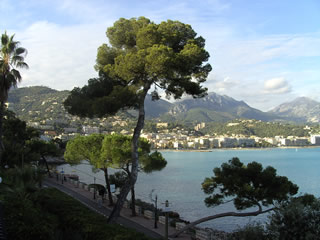 |
In no time we find back the pleasant habits of our wintering in Menton; although some days the sun is concealed by clouds, the temperature remains nice. The view, impressive, on the mounts of the Alpes maritimes is still fascinating - after more than twenty-five years ! But we enjoy also the more little things of our stay: the walk on the Boulevard de Garavan, the not ending "discovering" of the Vieille ville, the nice coffee at the Jardin du café, the reunion with Patricia - our teacher - and the other students of the Italian course, the nice walks in the hinterland - with splendid weather to Ste-Agnès and the Mont Ours mountain - and along the Sentier du littoral - the coast path -, the tour du Cap Martin on a nice Saturday morning, between two days of rain .... |
 |
Venice
04.11.08 From Menton (F) to Venice (I). During two weeks we were the guests of Michel en Mady; today we leave for Venice. Our stay passed at the velocity of an express, and separation is always hard, even when the nicest destinations are waiting for us ... Many thanks to you, Mady and Michel for your hospitality and all your attentions, we really enjoyed the stay at your boat; thanks to Marise and Rinaldo, Arlette and Guy, Thérèse and Claude, we enjoyed our reunion and we cherish the memory of our friendly meals ...
Thunderstorm, ink-dark skies. At 9.30 a.m. the taxi is taking us at the harbour of Garavan to bring us through a real flood to the station of Menton. The Train Corail to Milano Centrale has - due the bad weather - a delay of 15 minutes. Up to Genova this express is a real stopping train: we pass along the coast, along the harbours where we navigated this spring, San Remo, Aregai, Imperia, Alassio - our first Italian harbour last year - Loano, Finale Ligure, Savone, Varazze - our second stop; nice memories, splendid weather then, tropical storm now! After Genova and the impressive docks, the train is hurrying to the north. In Milano we have to take the IC train to Venice Santa Lucia: due to the delay, we have only four minutes to change. 3.15 p.m. Out of breath, to heavy loaded for this sprint, encouraged by the ticket inspector, we really collapse on our seats, just when the doors are closing ... followed by about ten panting passengers! Soon the outline of the Italian Alps, far off, sadly stand out against the black sky. The torrential rain is still falling and the night falls to early. Bergamo, Brescia, Verona, Vicenza, Padova: singing names despite the blackness of the weather. From Mestre - the suburb, sleep town and harbour - to Venice the railway and the highway run on the narrow strips linking the lagoon town to the continent. At 6.15 p.m. we get off the train, seven and a half hour after our departure from Menton.
Venice
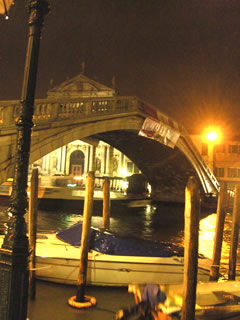 |
The simple, but correctly comfortable hotel we have booked on-line, was chosen for the situation: in a relative quiet small street, 150 m from the railway station, close to the vaporetti Ferrovia station on the Canal Grande. Pushed by our enthusiasm to be in Venise, we make a first acknowledgement walk in the no ending rain; it brings us, from the Ponte D. Scalzi, over the Canal Grande - close to our hotel -, through a maze of alleys, little places and small bridges to the area between the Canal Grande, Santa Croce and San Polo. Here, so we read in our guide, we should find small restaurants, unknown by the tourists. The first - Il Refolo, campo S. Giacomo dell'Orio - is closed but in the second we have noted - the Trattoria al Ponte del Megio, S. Croce - we eat common but delicious piatti tipici Veneziani - as a fegato (liver) alla veneziana , without pretension but with much flavour! When we come back into our hotel we keep from our nocturnal walk not only wet feet - flood in a large part of Italy and inundations in the south of Europe , so tells us the late television news - but above all this particular impression, marked by the mysterious atmosphere of this magnificent city that we'll explore during the two coming days, although a little incident will have an influence upon our schedule ... |
Venice, day 1. Nice weather. A large building, prestigious, but needing, in our opinion, some works on the facade. On the double door, two plaques in old cupper: it's here the Studio Dentistico of the Dottori Trolese & Zonter, second floor. Behind the large brown wooden door we discover a brand new dental surgery; we count at least eight assistants for the dottori. The very functional and tasteful furniture and the equipment reassure us a little bit. Big welcoming smiles, but we'll have to wait some ten minutes. In between the permanently coming and going patients one of the dottori will take care of Eric. X-Ray, diagnosis. He has to come back at 1.40 p.m.: then, the ancient filling will be removed and reconstituted together with the, yesterday evening, suddenly broken off part of the tooth.
This is the start of our short stay in Venice!
 |
But meanwhile time enough for a first big exploration. The vaporetto 2 takes us through the Canal Grande from the Ferrovia floating station to the Piazza San Marco, a breath cutting trip along the most magnificent palazzi built on this principal canal from the XIII th to the XVIII th century. We pass under the famous Ponte di Rialto and we enjoy the wonderful view; the numerous pictures we take will save our memories. In twenty unforgettable minutes this non-stop vaporetto carries us to the Piazza san Marco, this exceptional architectural unit that symbolises the magnificence of this once so powerful city. By the Giardinetti Reali and the Libreria Vecchia - on the left - and the Palazzo ducale - on the right - we reach by the Piazzetta, the Piazza San Marco. Rather than to exclaim into superlatives - we couldn't do otherwise, like so many other people - we try, silent and humble, to let's invade by all this beautifulness: the harmonious diversity of the Procuratie and their galleries, the Torre dell'Orologio, the Campanile - the tower was rebuilt after the spontaneous collapse in 1902 -, but it's the imposing Basilica San Marco, covered with marble and et mosaics, that takes our regards in possession. We sit down on one of the gangways - they are needed in case of the high water, the aqua alta, so baneful and dangerous for the treasures of Venice. |
12H00. Back to our hotel and ... the dentist; we take the vaporetto 1: same way on the Canal Grande, but the progression is more slowly, this vaporetto stops at all stations. So we can look with more attention to the individual edifices, and admire the ballet of the embarkations of all kind navigating sometimes (to) fast on the Canal - but we could 't deny the very good skills of the Venetian skippers and boat drivers!
14H20. The dentist has finished his work, and we, we can continue our discovering. With the vaporetto back to the Piazza San Marco, every time a new experience, a new admiration.
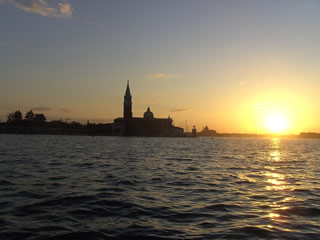 |
We want go to the top of the Campanile: from its 98m, going up with the lift, we'll have on this bright sunny day a dazzling view of the city, the buildings, the laguna, the islands, the large surroundings. This seems us a good way, with the discovering on the vaporetto - a easy way too for moving here, rational and fast - on this short city trip, to acquire rapidly landmarks and a global view. When at 4 p.m. the tower is closing, it's time to walk to the east, looking for a nice sunset, going along the large Canale San Marco, behind the Ponte dei Sospiri. Unfortunately the famous bridge is wrapped in a restoration habit showing that Lancia is the sponsor. Many restoration projects are now co-financed by prestigious brands and big societies, publicizing their sponsoring public by giant sceneries. By vaporetto 1 we reach the Canal Grande to visit from the station Salute the Chiesa Santa Maria della Salute. This church is a masterpiece of style baroque, erected in gratitude for the end of the plague in the year 1630; the construction was achieved only in 1687. The foundations are built on 1.106.657 oak, alder-tree and larch pillars. In the sacristy we admire The Wedding of Cana, by il Tintoretto; on the ceiling, three magnificent paintings by Tiziano Vecellio, Cain and Abel, Abrahams Sacrifice and David and Goliath, and, near the altar, some of his nice early works. |
Taking again vaporetto 1 we return to the Piazza San Marco from where we walk to the Rialto bridge trough the little streets where the very exclusive shops are grouped; after crossing the bridge we go back to our hotel passing the districts San Polo and Santa Croce. Those walks through a labyrinth of narrow alleys are a unique experience in this city without cars. At the dinner we discover a very typical plate, le seppie alla nero con polenta or all'inchiostro (cuttlefish in black sauce).
Venice, day 2. We take vaporetto 62 at station Ferrovia to visit Lido, the seaside resort of Venice: to reach this island in the laguna we'll make a real girocitta; it will show us the other visages of Venice: our vaporetto first follows the Canale di Cannaregio along the same named district to reach the north of the city. By the Canale delle Fondamente we proceed to the south-east; on the bank, numerous small yards, small harbours, then we arrive at the hospital and in the front of it, on the other bank of the canal, the green and nice San Michele island - the cemetery (no doubt, a discovering worth during our next visit); then appears the Darsena Grande - an ancient dock - and behind, the Arsenal where an other Venice is developing, new, centred on scientific research; more to the south, we see then the San Pietro di Castello church, on the island with the same name.
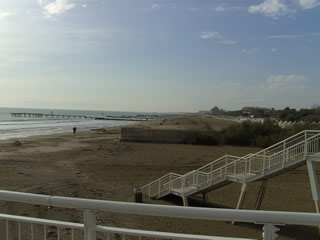 |
The vaporetto is now crossing the Laguna Veneta, in the direction of the long-limbed island of the Lido. From the Piazzale S. Maria Elisabetta, where we disembark, we go by a good step straight to the other side of this narrow island, taking the Gran viale to the beach close to the Piazzale Bucintoro. A morning marked by autumn atmosphere, after the thunderstorm of this night. On the beach, at the terrace of the cafe that want to remember to the Mostra, still deserted at this hour, we savour a delicious cappuccino, in the pale heat of a hesitating sun. Behind us, on the right, in his beautiful garden, the majestic Hôtel des Bains, immortalized by Luchino Visconti's Dead in Venice. The vaporetto takes us back at the end of the morning to Venice and the station Piazzale Roma, west of Ferrovia. We navigate on the Canale di San Marco and the Canale della Giudecca - between de island with the same name and the city -, what allows us to discover the south side of Venice. |
From the Piazzale Roma we walk through the Giardino Papadopoli, a pleasant small park, oasis of green in a city where nature is a luxurious exception. We are on the way to the Jewish Ghetto and Cannaregio. Crossing the Ponte d. Guglie we arrive at the synagogue and after the Calle del Ghetto Vecchio we come out onto the Campo del Ghetto Nuovo - close to the Museo Ebraico. More to the north, we reach the Sant'Alvisio church dating from 1388. We want to visit it for three works of Tiepolo, the Christ Carrying the Cross, the Crown of Thorns, and the Flagellation, impressive artistic meetings, inner dialogue with masterpieces.
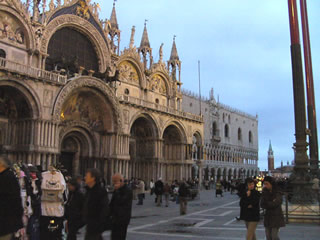 |
Back to Cannaregio, where we have a late but light meal, along the canal on the terrace of the Ostaria da Rioba. For the dessert we want to reach the Gelateria Causin, in the district of the university, but a deception is waiting for us: the ice cream isn't home made anymore. We find a simple artisan made ice cream not far from the Chiesa Santa Maria dei Carmini; the sober front is in Renaissance style - near the Scuola grande del Carmini -, where we admire an Adoration of the shepherds, masterpiece by Cina da Conegliano. By the vaporetto we go back to the Piazza San Marco where the famous Caffè Florian ( 1720 ) - meeting place of so numerous artists - is attracting us. The cappuccino and the hot chocolate which are served are fully taking part in the respectable interior. After a last look to the Piazza San Marco we return to our hotel passing well animated streets and squares. |
In the nice Osteria Mocenigo in the Saizzada San Stae - a little bit deserted in this late evening in November, we get a meal composed of a small antipasti of fish, fried fish and delicious lamb chops, and a charming fresh house wine. On the way back the concerns about the cross to Igoumenitsa are meeting with the images of our to short visit of this city with a very particularly enchanting charm ...
Back to Greece
07-08.11.08 From Venice (I) to Igoumenitsa and Lefkas (GR).
The shuttle of the Minoan lines brings us about 11 a.m. from the bus station at the Piazzale Roma to the ferry harbour, really not easy accessible. After picking up our tickets, booked on-line, we have to wait a while before embarkation. When at 12.30 we can go on board we have to change to the Greek hour: the boat will not leave at 2 but at 3 p.m.
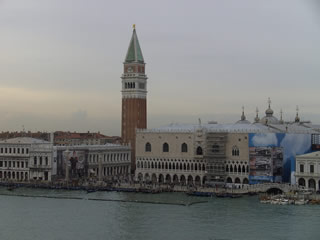 |
The Barcelona Express has taken his pilot on board, and, escorted by the Neptun - the tug that will keep a watch on the stern of the ship - the large ferry starts his slow progression by the Canale della Giudecca and the Canale di San Marco in the direction of the Adriatic Sea, a slow navigation, full of held up power, majestic, trying to worthy of the history of Venice. With a average speed of four knots the huge vessel moves along banks where vulnerable treasures are suffering the wounds of an intense and never ending nautical traffic; taxis, vaporetti, big vessels, small boats, they all have drawn the visage of Venice and, today too, they still remind Venice of its vocation and its immense past. But Venice is in pain, despite the present cares, gigantic but late ... this jewel might disappear under the knocks down of the surrounding violence, the pollution, the consequences of the climate, the industrialisation, the human pressure. |
The pilot leaves the ferry at the new, ultimate, controversial protection for Venice, source of polemic: the hydraulic, under construction being dam of the MoSe-project.
5 p.m. At his cruising speed the ferry making way to Greece enters into the night when the horizon on the coastline is colouring pink.
08.11.08 11 a.m. The Albanian coast is at a few nautical miles at our port, when we can recognise, in front of us, at starboard the first Greek island of Othonoi. Further of, it's Corfu.
12.30. Igoumenitsa: the new ferry harbour is very far from the town. A taxi driver makes a deal: for a good price. He brings us, and our English marina-neighbour, to Lefkas.
An hour later, after a terrifying drive along the coast, we arrive at Lefkas Marina. Some minutes later, we step on board of our boat.
Click here for the data in Kortom, 4.9.1)
Click here to continue the voyage: 4.2. Greece: the aim of our project, Horto and the Aegean, and the return to Lefkas (2009) Ep6.
Back to the general overview, click here.
Greece ... some facts and dates!
Greece is a parliamentary democracy (Constitution 1975), member of the European Union, and presents itself in the recent years more as a Balkan country. A chronology (based on data of Larousse, oc): 2009-2011: The elections of October 4 2009, gave the Nea Demokratia (N.D.), the party of outgoing Prime Minister Karamanlis, a resounding defeat. Big winner is George Papandreou; with his PASOK party: he obtains an absolute majority in parliament. Rapidly Greece with its immense national debt is in sights of markets; the interest rates for the loans reach summits. The IMF and Europe are forced to fly to the assistance of Greece. A draconian austerity plan is elaborated. See debt crisis http://en.wikipedia.org/wiki/Economy_of_Greece and the following report of the European Parliament: If you want to read more about Greece click here http://en.wikipedia.org/wiki/Greece The prices seem at times very variable and tourist-related. To illustrate the following example: in 2007 "one machine wash + dryer + folding" cost 7 euros, in 2009, without any other or additional service, 15 euros ... Ka at informed for the same service at a laundry in Leftward: it was the same price - 15 euros -, the next day a friend informed at the same laundry: 12 euros still for the same service! - opening hours shops: Monday & Wednesday & Saturday: 07H30/08H00-14H00/14H30; Tuesday & Thursday & Friday: 07H30/08H00-1400/14H30 and 18H00-21H00/21H30 - corruption: in the Corruption Perception Index (CPI) ranking table 2009 of 180 countries Greece is at the 71st place with a CPI of 3.8, ex aequo with Bulgaria, FYR Makedonia and Romania; New-Zealand has the best ranking (9.4), Denmark is second (9.3), then (3) Singapore (9.2), (4) Sweden (9.2), (5) Switzerland (9.0), (6) ex aequo the Netherlands and Finland (8.9), (14) Germany (8.0), (17) the United-Kingdom (7.7), (19) the United-States (7.5), (21) Belgium (7.1), (24) France (6.9), (32) Spain (6.1), (63) Italy (4.3), (180) Somalia (1.1) ( source: Transparency International, www.transparency.org ) - A wide-ranging survey conducted by Insites Consulting with Greek's Interactive Advertising Bureau (IAB) shows that, despite only 49% of the Greeks are internet users, "the Greek users love being online more than "the average European internet user": from all Greek internet users 66% log daily onto the internet (compared to 53% E. a.); remains 24% daily more than 1 hour online (c.t. 17% E. a.); is 37% willing to provide personal data to advertisers (c.t. 26% E. a.); have 63% created a net profile at Facebook, Twitter, MySpace or LinkedIn, c.t. 45% E. a.; update 33% daily his profile (c. t. 15% E. a.), has 19% mobile internet (c.t. 15% E. a.), check 54% daily his emails (E. a. 37%) . According to Haris Rougas of IAB Hellas, "this is related to Greek psychology. Greeks are very sociable and all the evidence shows that we have transferred our offline communicative habits online. [...] Greeks are proving the most socially active and innovative. Our inherent character of Greeks is to be very curious and we love to try out new devices." (cit.in: Athens News, 13-19 November 2009, p.25) - With a market penetration of 123% mobile phone usage is in Greece among the highest in the world .. . (in: Athens News, 13-19 November 2009, p.25) - A study by the NIELSEN INSTITUTE sets Greece on the second place in the world as most brand sensitive country, after Hong Kong and before India ... (in: Marie-Claire (French magazine), November 2009, p.29; The Nielsen Company, Nielsen USA including France, www.nielsen.com . |
Click here to continue the voyage: 4.1.2 Greece: wintering at Lefkas, explorations, discoveries and rediscoveries (2008-2009) Ep5.2
Back to the general overview, click here.
| Top |
